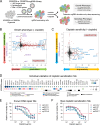Large-scale CRISPR screening in primary human 3D gastric organoids enables comprehensive dissection of gene-drug interactions
- PMID: 40813572
- PMCID: PMC12354852
- DOI: 10.1038/s41467-025-62818-3
Large-scale CRISPR screening in primary human 3D gastric organoids enables comprehensive dissection of gene-drug interactions
Abstract
Understanding how genes influence drug responses is critical for advancing personalized cancer treatments. However, identifying these gene-drug interactions in a physiologically relevant human system remains a challenge, as it requires a model that reflects the complexity and heterogeneity among individuals. Here we show that large-scale CRISPR-based genetic screens, including knockout, interference (CRISPRi), activation (CRISPRa), and single-cell approaches, can be applied in primary human 3D gastric organoids to systematically identify genes that affect sensitivity to cisplatin. Our screens uncover genes that modulate cisplatin response. By combining CRISPR perturbations with single-cell transcriptomics, we resolve how genetic alterations interact with cisplatin at the level of individual cells and uncover an unexpected link between fucosylation and cisplatin sensitivity. We identify TAF6L as a regulator of cell recovery from cisplatin-induced cytotoxicity. These results highlight the utility of human organoid models for dissecting gene-drug interactions and offer insights into therapeutic vulnerabilities in gastric cancer.
© 2025. The Author(s).
Conflict of interest statement
Competing interests: C.J.K. declares outside interest in Surrozen, Inc., Mozart Therapeutics, and NextVivo, Inc. J.S.W. declares outside interest in KSQ Therapeutics, Maze Therapeutics, Chroma Medicine, Amgen, Tessera Therapeutics, 5AM Ventures, and Third Rock Ventures. J.S.W. has filed patent applications related to CRISPRi and CRISPRa screening. J.C. is an employee and shareholder of Altos Labs. The remaining authors declare no competing interests.
Figures






References
-
- Sato, T. et al. Single Lgr5 stem cells build crypt-villus structures in vitro without a mesenchymal niche. Nature459, 262–265 (2009). - PubMed
MeSH terms
Substances
LinkOut - more resources
Full Text Sources
Medical

